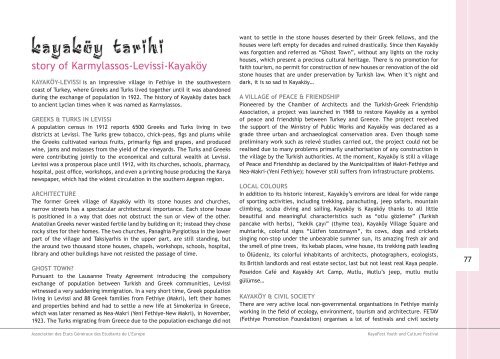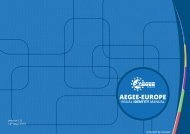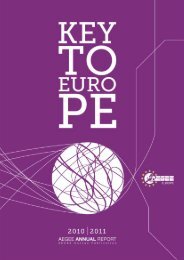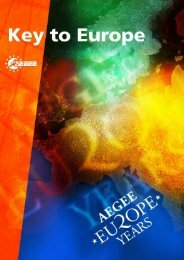turkish-greek civic dialogue - AEGEE Europe
turkish-greek civic dialogue - AEGEE Europe
turkish-greek civic dialogue - AEGEE Europe
You also want an ePaper? Increase the reach of your titles
YUMPU automatically turns print PDFs into web optimized ePapers that Google loves.
story of Karmylassos-Levissi-Kayaköy<br />
KAYAKÖY-LEVISSI is an impressive village in Fethiye in the southwestern<br />
coast of Turkey, where Greeks and Turks lived together until it was abandoned<br />
during the exchange of population in 1922. The history of Kayaköy dates back<br />
to ancient Lycian times when it was named as Karmylassos.<br />
GREEKS & TURKS IN LEVISSI<br />
A population census in 1912 reports 6500 Greeks and Turks living in two<br />
districts at Levissi. The Turks grew tobacco, chick-peas, figs and plums while<br />
the Greeks cultivated various fruits, primarily figs and grapes, and produced<br />
wine, jams and molasses from the yield of the vineyards. The Turks and Greeks<br />
were contributing jointly to the economical and cultural wealth at Levissi.<br />
Levissi was a prosperous place until 1912, with its churches, schools, pharmacy,<br />
hospital, post office, workshops, and even a printing house producing the Karya<br />
newspaper, which had the widest circulation in the southern Aegean region.<br />
ARCHITECTURE<br />
The former Greek village of Kayaköy with its stone houses and churches,<br />
narrow streets has a spectacular architectural importance. Each stone house<br />
is positioned in a way that does not obstruct the sun or view of the other.<br />
Anatolian Greeks never wasted fertile land by building on it; instead they chose<br />
rocky sites for their homes. The two churches, Panaghia Pyrgiotissa in the lower<br />
part of the village and Taksiyarhis in the upper part, are still standing, but<br />
the around two thousand stone houses, chapels, workshops, schools, hospital,<br />
library and other buildings have not resisted the passage of time.<br />
GHOST TOWN?<br />
Pursuant to the Lausanne Treaty Agreement introducing the compulsory<br />
exchange of population between Turkish and Greek communities, Levissi<br />
witnessed a very saddening immigration. In a very short time, Greek population<br />
living in Levissi and 88 Greek families from Fethiye (Makri), left their homes<br />
and properties behind and had to settle a new life at Simokeriza in Greece,<br />
which was later renamed as Nea-Makri (Yeni Fethiye-New Makri), in November,<br />
1923. The Turks migrating from Greece due to the population exchange did not<br />
Association des Etats Généraux des Etudiants de L’<strong>Europe</strong><br />
want to settle in the stone houses deserted by their Greek fellows, and the<br />
houses were left empty for decades and ruined drastically. Since then Kayaköy<br />
was forgotten and referred as “Ghost Town”, without any lights on the rocky<br />
houses, which present a precious cultural heritage. There is no promotion for<br />
faith tourism, no permit for construction of new houses or renovation of the old<br />
stone houses that are under preservation by Turkish law. When it’s night and<br />
dark, it is so sad in Kayaköy…<br />
A VILLAGE of PEACE & FRIENDSHIP<br />
Pioneered by the Chamber of Architects and the Turkish-Greek Friendship<br />
Association, a project was launched in 1988 to restore Kayaköy as a symbol<br />
of peace and friendship between Turkey and Greece. The project received<br />
the support of the Ministry of Public Works and Kayaköy was declared as a<br />
grade three urban and archaeological conservation area. Even though some<br />
preliminary work such as relevé studies carried out, the project could not be<br />
realised due to many problems primarily unathorisation of any construction in<br />
the village by the Turkish authorities. At the moment, Kayaköy is still a village<br />
of Peace and Friendship as declared by the Municipalities of Makri-Fethiye and<br />
Nea-Makri-(Yeni Fethiye); however still suffers from infrastructure problems.<br />
LOCAL COLOURS<br />
In addition to its historic interest, Kayaköy’s environs are ideal for wide range<br />
of sporting activities, including trekking, parachuting, jeep safaris, mountain<br />
climbing, scuba diving and sailing. Kayaköy is Kayaköy thanks to all little<br />
beautiful and meaningful characteristics such as “otlu gözleme” (Turkish<br />
pancake with herbs), “kekik çayı” (thyme tea), Kayaköy Village Square and<br />
muhtarlık, colorful signs “Lütfen tozutmayın”, its cows, dogs and crickets<br />
singing non-stop under the unbearable summer sun, its amazing fresh air and<br />
the smell of pine trees, its kebab places, wine house, its trekking path leading<br />
to Ölüdeniz, its colorful inhabitants of architects, photographers, ecologists,<br />
its British landlords and real estate sector, last but not least real Kaya people.<br />
Poseidon Café and Kayaköy Art Camp, Mutlu, Mutlu’s jeep, mutlu mutlu<br />
gülümse…<br />
KAYAKÖY & CIVIL SOCIETY<br />
There are very active local non-governmental organisations in Fethiye mainly<br />
working in the field of ecology, environment, tourism and architecture. FETAV<br />
(Fethiye Promotion Foundation) organises a lot of festivals and civil society<br />
KayaFest Youth and Culture Festival<br />
77







